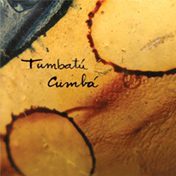TUMBATÚ CUMBÁ
ALBUM: TUMBATÚ CUMBÁ
ARTIST: TUMBATÚ CUMBÁ
LABEL: SURAMUSIC

Tumbatú Cumbá is fronted by brother and sister Nicolas Falcof (guitar,vocals, percussion) and Magalí Falcof (vocals and percussion) and includes members Julian Solarz (piano, percussion and vocals), Cecilia Fraiman (vocals), Sebastian Dezeo (electric bass) and Bernardo Ucha (percussion). The group describes itself as “Buenos Aires musicians who fuse Latin American styles and rhythms from the wide-ranging folk traditions from every corner of the continent.” In their 2007 eponymous recording, Tumbatú Cumbá gives a contemporary feel to traditional Afro-Latin rhythms and explores genres that have gone through many re-births as each Latin-American generation has searched for its musical roots.
The CD opens with Ê-emoriô, a song based on a traditional Afro-Brazilian chant, but attributed to Brazilian legends Gilberto Gil and João Donato who popularized it. With several guest percussionists and vocalists, the track is a call and response between the chorus and the rich vocals of Magalí Falcoff.
The track Ritmo de Negros is a festejo by Peruvian composer Pepe Vasquez. Festejo in its original form was similar to Brazilian capoiera, in which men formed a circle and performed choreographed fighting set to music. By the 19th century, the festejo had blended with Spanish music and became more of a collective celebratory music, rather than a way to covertly practice martial arts. Today, musicians like Pepe Vasquez have preserved and transformed the festejo with the addition of jazz and salsa elements and an expansion of the instrumentation.
In Milonga Trunca, by Niolás Falcoff, the group offers us a modern, jazzy sound over the traditional milonga rhythm with beautiful vocals by Magali Falcof. While the Tango is well known internationally, its Afro-Argentine and Afro-Uruguayan precursors, the Candombe and Milonga, are less well known. The candombe was a fusion of various African musical traditions that existed within Buenos Aires during the 19th century. This style was copied by rural Argentines who settled in Buenos Aires in search of work at the end of the 19th century, fusing it with their own musical traditions. The result was the milonga rhythm and dance. While the tango became king at the beginning of the 20th century, the milonga fell to the wayside until the 1930s when tango writers, most notably Homero Manzi, began composing milongas for the tango audience that had exploded over the preceding decades.
On the track Oro y Plata, by Manzi, Tumbatú Cumbá gives 21st century listeners a taste of the upbeat rhythms of milonga and candombe that one would have heard in the working class neighborhoods of early 20th century Buenos Aires.
The CD ends with the Candombe Bajó del Arbol un Tambor, by Uruguay’s Washington Carrosco. As with the opening track, the group shows its percussive skill, performing on instruments typical of the genres. Magalí Falcof’s vocals float above the percussion grooves.
Musical styles go through births, marriages, deaths and rebirths. Tumbatú Cumbá successfully reaches across borders to bring together styles that have, at different times and in different places, been central to a culture, only to slip away and then return, as an expression of a new musical generation. Tumbatú Cumbá adds its own link to the chain of Latin folk music.
Enrico Del Zotto is an educator and musician who lives in Fullerton. He recently completed his M.A. in Music and Culture at San Francisco State University.












